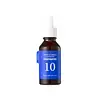What's inside
What's inside
 Key Ingredients
Key Ingredients

 Benefits
Benefits

 Concerns
Concerns

 Ingredients Side-by-side
Ingredients Side-by-side

Water
Skin ConditioningPropanediol
SolventButylene Glycol
HumectantGlycerin
Humectant1,2-Hexanediol
Skin ConditioningGlycyrrhiza Glabra Root Extract
BleachingGlycereth-26
HumectantAmmonium Acryloyldimethyltaurate/Vp Copolymer
Betaine
HumectantCaprylyl/Capryl Glucoside
CleansingPolyglyceryl-10 Laurate
Skin ConditioningDipropylene Glycol
HumectantChamomilla Recutita Flower Extract
MaskingSodium Hyaluronate
HumectantXanthan Gum
EmulsifyingDisodium EDTA
Polyglyceryl-10 Oleate
Skin ConditioningJuniperus Mexicana Oil
MaskingRosa Damascena Flower Oil
MaskingDipotassium Glycyrrhizate
HumectantPogostemon Cablin Leaf Oil
MaskingVetiveria Zizanoides Root Oil
MaskingGuaiazulene
AntimicrobialBeta-Glucan
Skin ConditioningPolyglutamic Acid
Skin ConditioningWater, Propanediol, Butylene Glycol, Glycerin, 1,2-Hexanediol, Glycyrrhiza Glabra Root Extract, Glycereth-26, Ammonium Acryloyldimethyltaurate/Vp Copolymer, Betaine, Caprylyl/Capryl Glucoside, Polyglyceryl-10 Laurate, Dipropylene Glycol, Chamomilla Recutita Flower Extract, Sodium Hyaluronate, Xanthan Gum, Disodium EDTA, Polyglyceryl-10 Oleate, Juniperus Mexicana Oil, Rosa Damascena Flower Oil, Dipotassium Glycyrrhizate, Pogostemon Cablin Leaf Oil, Vetiveria Zizanoides Root Oil, Guaiazulene, Beta-Glucan, Polyglutamic Acid
Water
Skin ConditioningGlycerin
HumectantIsostearyl Neopentanoate
EmollientButylene Glycol
HumectantPentylene Glycol
Skin ConditioningPolysorbate 20
EmulsifyingTambourissa Trichophylla Leaf Extract
Skin ConditioningGlyceryl Acrylate/Acrylic Acid Copolymer
HumectantDimethicone
EmollientDimethiconol
EmollientAmmonium Polyacryloyldimethyl Taurate
Emulsion StabilisingDisodium EDTA
Acetyl Dipeptide-1 Cetyl Ester
Skin ConditioningIngredients Explained
These ingredients are found in both products.
Ingredients higher up in an ingredient list are typically present in a larger amount.
Butylene Glycol (or BG) is used within cosmetic products for a few different reasons:
Overall, Butylene Glycol is a safe and well-rounded ingredient that works well with other ingredients.
Though this ingredient works well with most skin types, some people with sensitive skin may experience a reaction such as allergic rashes, closed comedones, or itchiness.
Learn more about Butylene GlycolDisodium EDTA plays a role in making products more stable by aiding other preservatives.
It is a chelating agent, meaning it neutralizes metal ions that may be found in a product.
Disodium EDTA is a salt of edetic acid and is found to be safe in cosmetic ingredients.
Learn more about Disodium EDTAGlycerin is already naturally found in your skin. It helps moisturize and protect your skin.
A study from 2016 found glycerin to be more effective as a humectant than AHAs and hyaluronic acid.
As a humectant, it helps the skin stay hydrated by pulling moisture to your skin. The low molecular weight of glycerin allows it to pull moisture into the deeper layers of your skin.
Hydrated skin improves your skin barrier; Your skin barrier helps protect against irritants and bacteria.
Glycerin has also been found to have antimicrobial and antiviral properties. Due to these properties, glycerin is often used in wound and burn treatments.
In cosmetics, glycerin is usually derived from plants such as soybean or palm. However, it can also be sourced from animals, such as tallow or animal fat.
This ingredient is organic, colorless, odorless, and non-toxic.
Glycerin is the name for this ingredient in American English. British English uses Glycerol/Glycerine.
Learn more about GlycerinWater. It's the most common cosmetic ingredient of all. You'll usually see it at the top of ingredient lists, meaning that it makes up the largest part of the product.
So why is it so popular? Water most often acts as a solvent - this means that it helps dissolve other ingredients into the formulation.
You'll also recognize water as that liquid we all need to stay alive. If you see this, drink a glass of water. Stay hydrated!
Learn more about Water